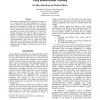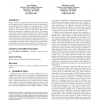40 search results - page 2 / 8 » Developing performance metrics for the supervisory control o... |
FLAIRS
2004
13 years 6 months ago
2004
Robots that can adapt and perform multiple tasks promise to be a powerful tool with many applications. In order to achieve such robots, control systems have to be constructed that...
HRI
2007
ACM
13 years 9 months ago
2007
ACM
Human control of multiple robots has been characterized by the average demand of single robots on human attention or the distribution of demands from multiple robots. When robots ...
IROS
2007
IEEE
13 years 11 months ago
2007
IEEE
— Any system that has the capability to diagnose and recover from faults is considered to be a fault-tolerant system. Additionally, the quality of the incorporated fault-toleranc...
TROB
2002
13 years 4 months ago
2002
We have designed and built a set of miniature robots called Scouts and have developed a distributed software system to control them. This paper addresses the fundamental choices we...
ICRA
2002
IEEE
13 years 10 months ago
2002
IEEE
Visual Servoing has been a viable method of robot manipulator control for more than a decade. Image-Based Visual Servoing (IBVS), in particular, has seen considerable development ...


